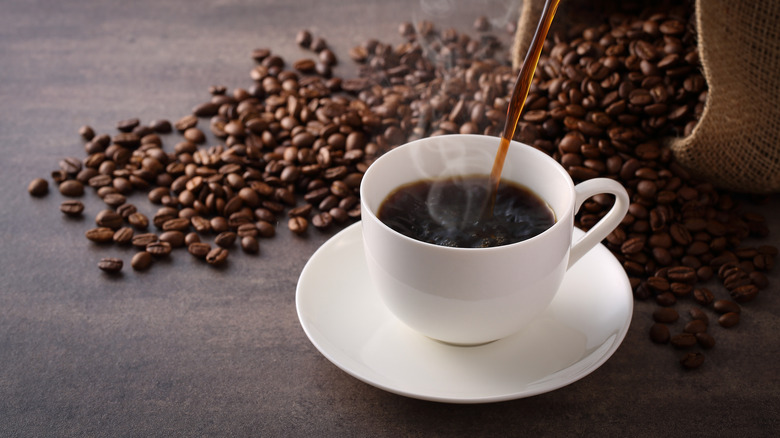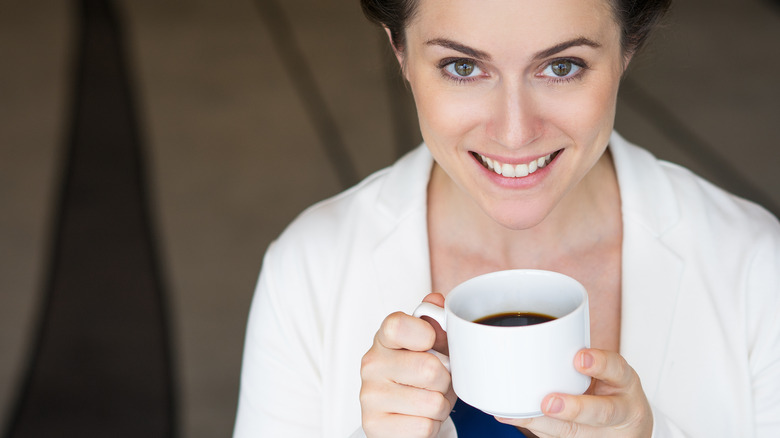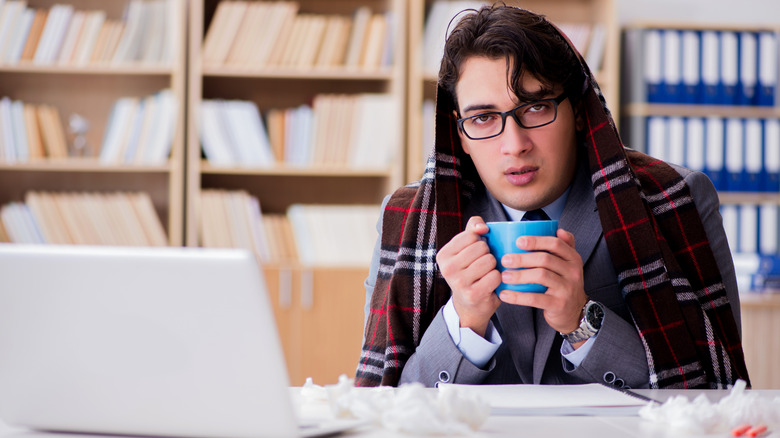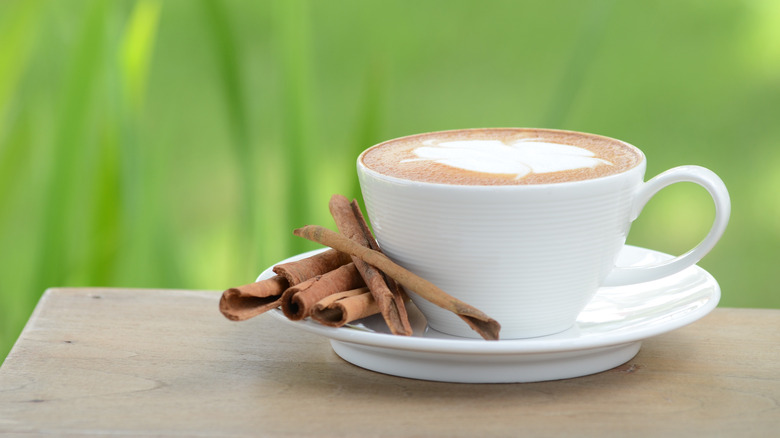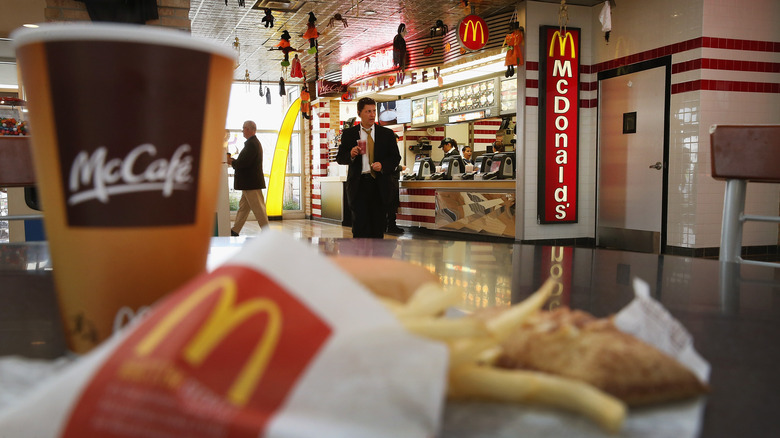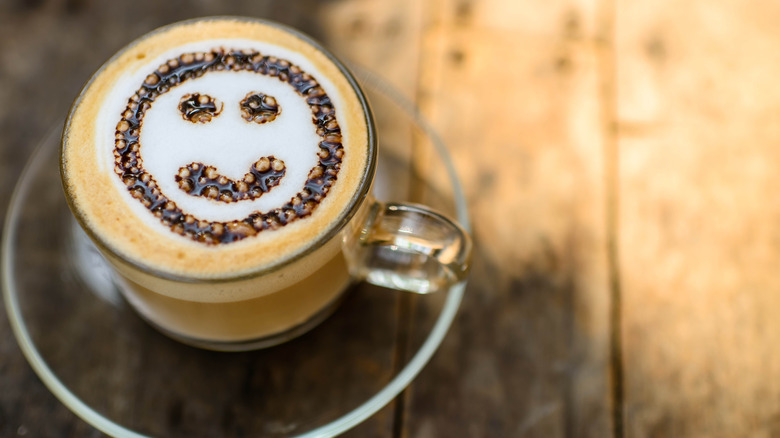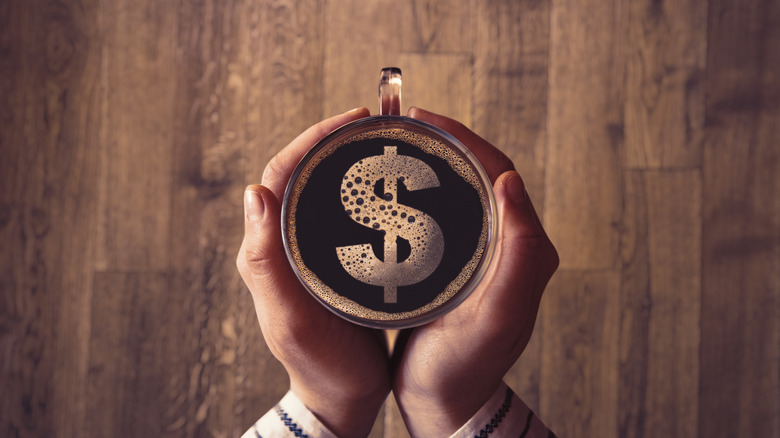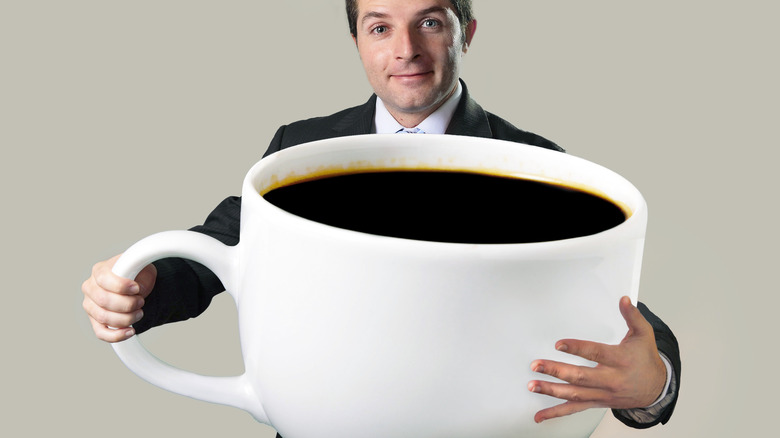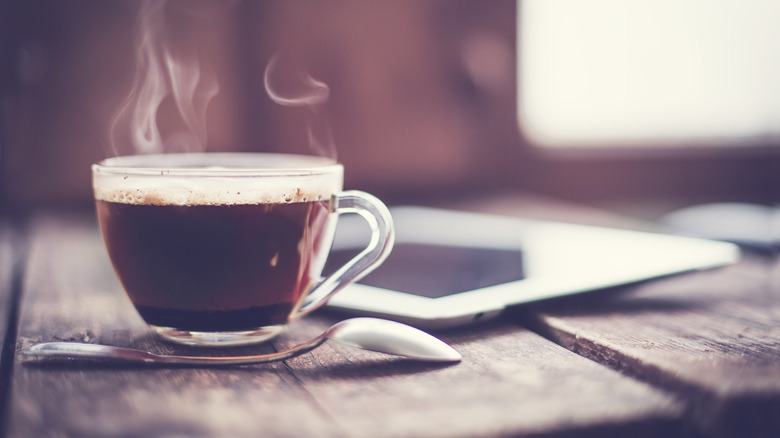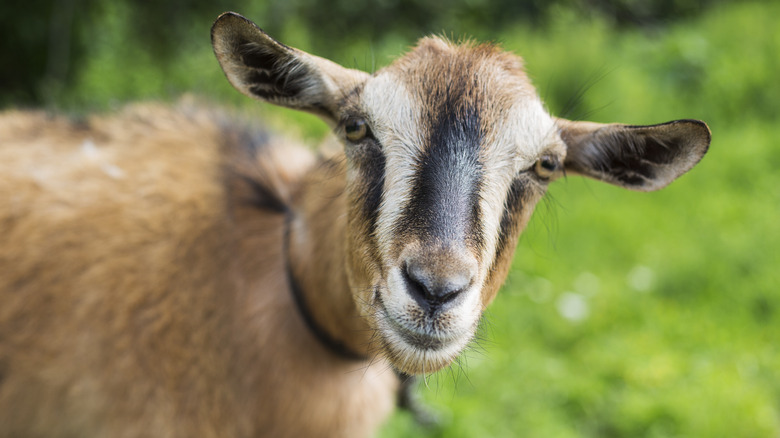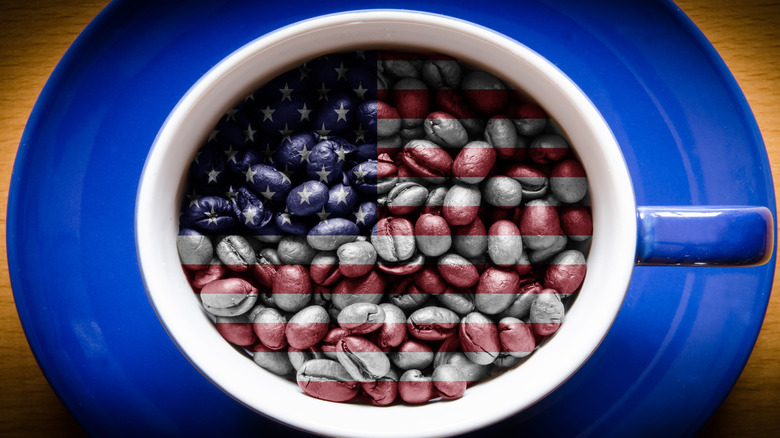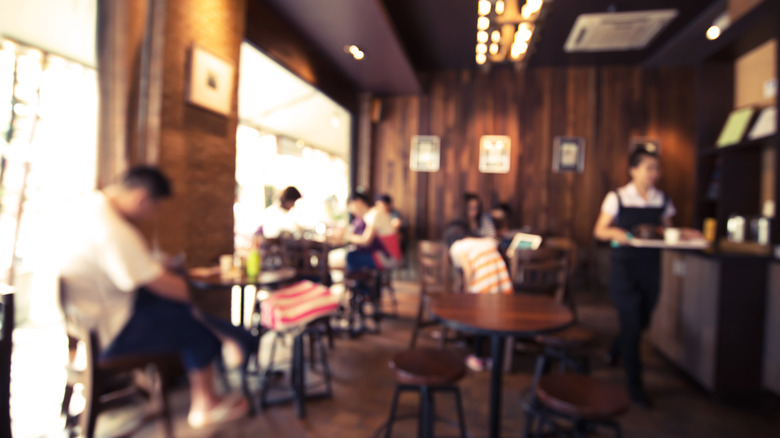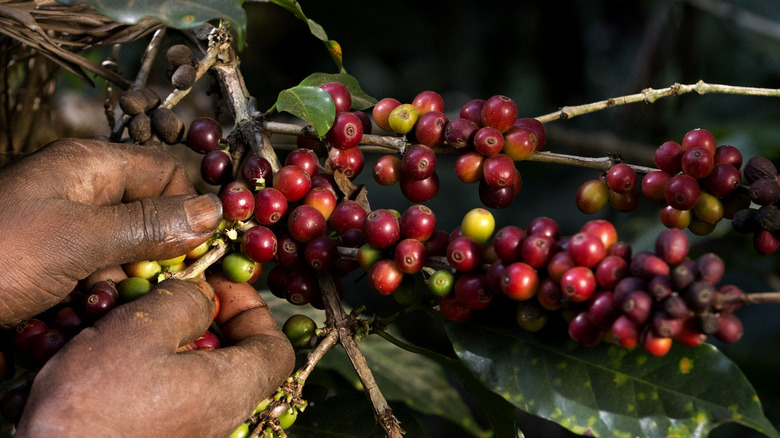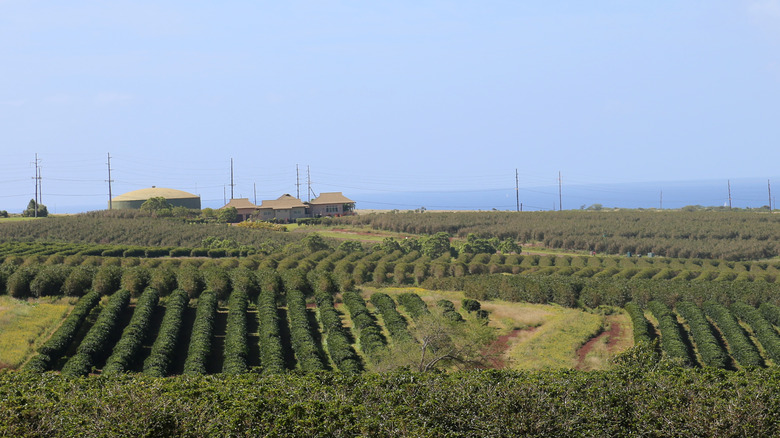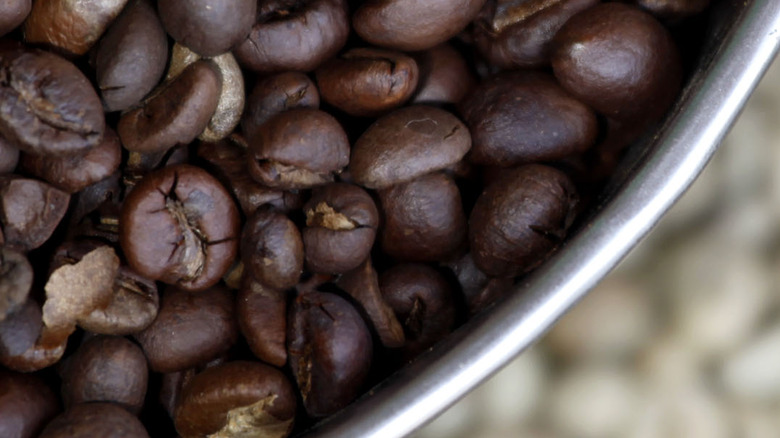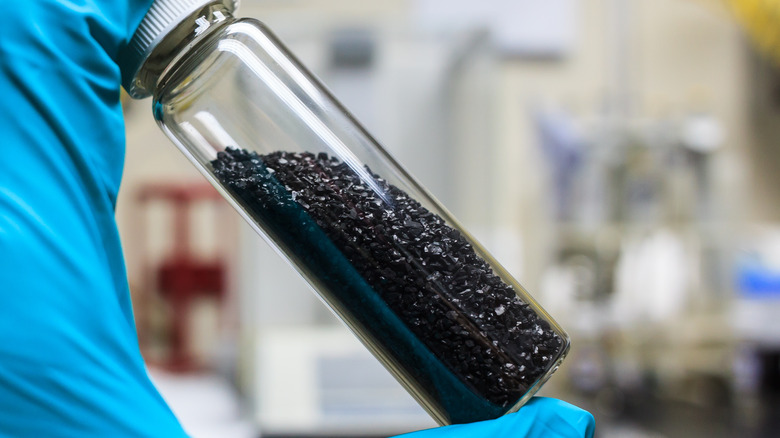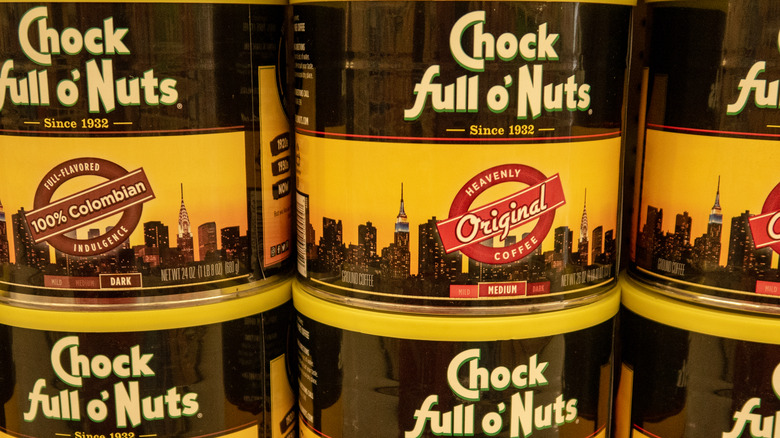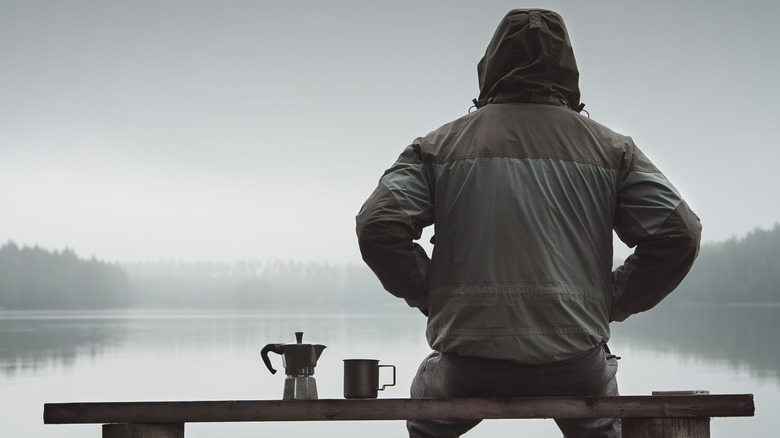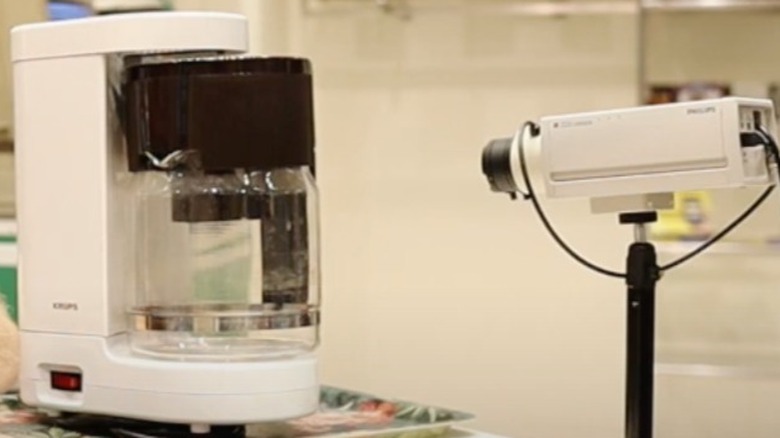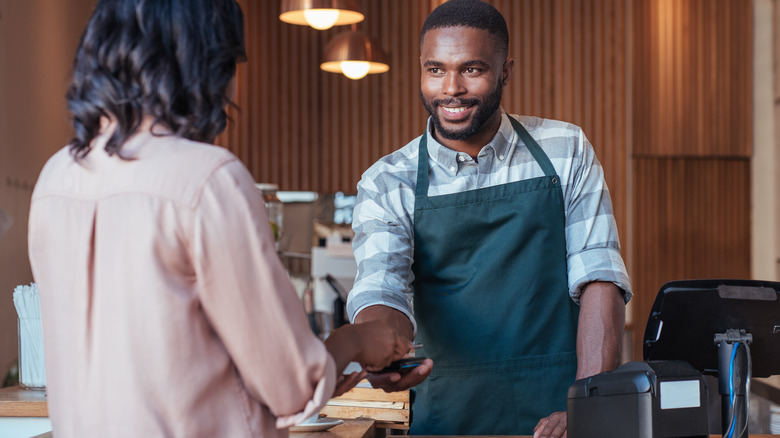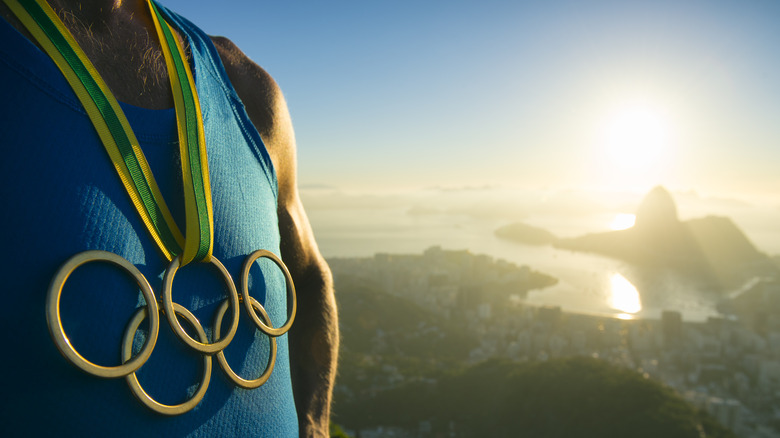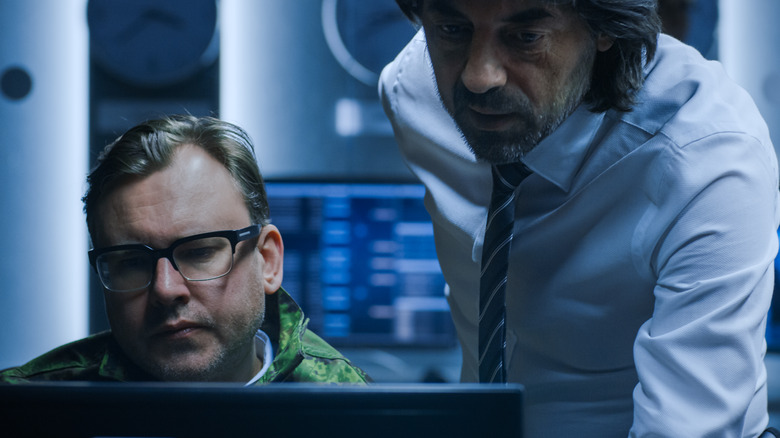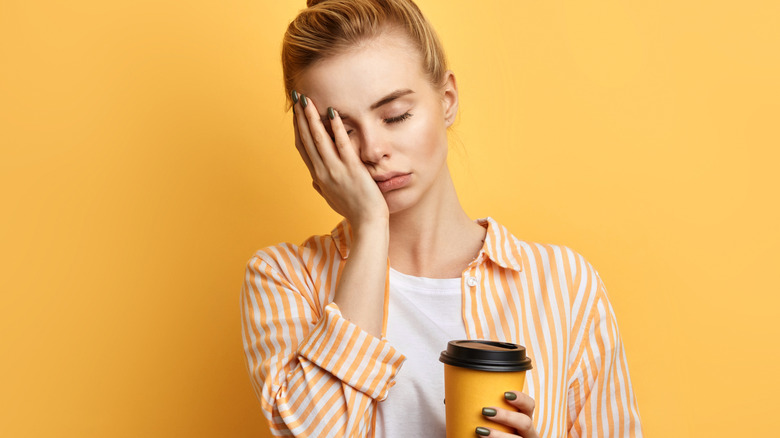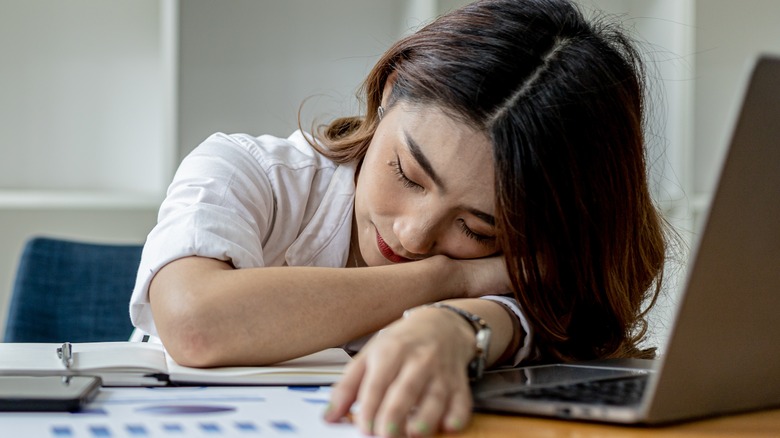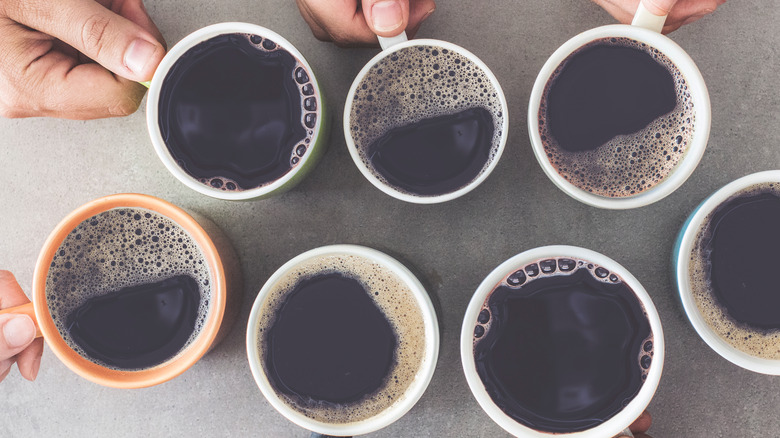The Untold Truth Of Coffee
Americans are having a huge love affair with coffee. In fact, a 2018 survey by the National Coffee Association said about 64 percent of Americans have at least one cup of coffee every single day. And most of us aren't going for the cheap stuff, either. The U.S. Census Bureau says that Americans spend an average of $1,100 each year on coffee alone — more than they spend on pets, entertainment, and even car insurance. That's quite a chunk of change for a caffeinated beverage.
So what is it about coffee that keeps us coming back for more? What does drinking all that coffee do to our bodies? And how in the world did we start drinking it anyway? No matter how much you love coffee, there's a good chance you don't know some of these facts and more, so we're here to fill you in. This is the untold truth of coffee — no self-respecting coffee lover should take another sip before getting all the dirt.
Coffee can make you smarter
If you want an extra excuse for drinking coffee first thing in the morning, here's one to try out: It actually makes you smarter. When you drink caffeine, your dopamine increases, and neurons in your brain fire more quickly than normal. This leads to improvements in your mood, energy levels, and reaction times. So when you feel like your brain is fuzzy until you drink your first cup of coffee in the morning, you're right. Coffee doesn't just make you more alert, it actually makes you smarter as well.
You can overdose on coffee
While coffee does make you smarter, don't go overboard with drinking it in the hopes that you'll win the Nobel Peace Prize. Like many great things in life, you can overdose on coffee. And the results aren't pretty. Coffee overdose symptoms include anxiety, heart palpitations, dizziness, and even throwing up. People have varying levels of coffee sensitivity, so if you want to know how much coffee is too much for you, use this coffee overdose calculator.
Coffee is the biggest source of antioxidants in your diet
If you thought blueberries were the only way to get your antioxidants, think again. While fruits and vegetables do have a lot of antioxidants, coffee probably provides more antioxidants in your diet than anything else.
Most Americans drink a lot more coffee than they eat fruits and vegetables, and coffee contains a lot of antioxidants per serving. Some of these antioxidants may prevent things like heart disease, cancer, and type 2 diabetes. So if you want to stay healthy, drink up. Make sure to eat your fruits and vegetables as well, as coffee contains a different type of antioxidants than they do.
A cup of coffee from McDonalds has half the caffeine as one from Starbucks
Speaking of caffeine levels, not all coffee is created equal when it comes to caffeine content. One of the reasons people love Starbucks so much is the high caffeine content of its coffee. A Grande Clover Brewed Coffee contains a whopping 375 milligrams of caffeine and a Grande Americano contains 225 milligrams of caffeine.
In comparison, a medium coffee from McCafe only has 145 milligrams of caffeine. That's less than half of the grande Starbucks coffee! The bottom line? Know how your body handles caffeine and find out ahead of time how much caffeine will be in the coffee you buy. That way you won't overdose — and you know who to skip if you really need a jolt.
Coffee is more potent when you drink it midmorning
Do you drink your coffee before you do anything else in the morning? If so, you might want to change your timing. In a 2013 study, researchers found that the best time to drink coffee is actually between 9:30 and 11:30. That's because cortisol, a hormone related to stress and alertness, naturally dips midmorning. Your cortisol levels actually peak between eight to nine in the morning, so if you drink your coffee then, when your body is already naturally alert, you won't get the same jolt as you will an hour or so later.
Some coffee costs almost a thousand dollars a pound
If you think Starbucks coffee is expensive, you'll be shocked to learn that a special type of coffee from Thailand costs almost $1,000 a pound. Yes, you read that right. It's called Black Ivory Coffee and it's made from Thai Arabica coffee beans that have been digested and then pooped out by elephants in Ban Taklang, a rural Thai village.
There are two reasons you would want to pay an exorbitant amount of money to drink coffee made from beans digested by Thai elephants. The digestion process breaks down the bitter proteins found in most coffee. Elephants' digestion also ferments the beans, helping the fruit from the coffee pulp get into the bean.
Another type of coffee, called Kopi Luwak, is made from the poop of civets, a catlike animal in Indonesia and the Philippines. While this coffee will still set you back over $200 per pound, it'll be a little easier on your wallet, and you'll still get to brag that you've tasted some of the most expensive coffee on Earth.
The largest cup of coffee ever held almost 4,000 gallons
Think your coffee mug is enormous? Check out the largest cup of coffee ever made. It can hold almost 4,000 gallons of coffee. Caffé Bene in South Korea created it in 2014 at their global roasting plant in Yangju, Gyeonggi Province. The mug measures ten feet, ten inches tall and was filled with a black iced Americano for the Guinness Book of World Records.
You could once be put to death for drinking coffee
While most people love coffee, Sultan Murad IV, a ruler of the Ottoman Empire in the 17th century, was not one of them. He despised it so much that he would disguise himself and then walk around the streets of Istanbul with a 100-pound broadsword. Anyone he found drinking coffee would be decapitated on the spot.
The next sultan was a little nicer to coffee drinkers, but not much. If you were caught drinking coffee once, you would be beaten with a club. The second time, you were sewn into a leather bag and thrown into the river. If you've unsuccessfully tried to limit your coffee intake, you can take heart that even these extreme measures weren't enough to stop Turkish people from drinking coffee.
Coffee was first discovered by goats
The first mammals to taste coffee weren't humans — they were Ethiopian goats. While no one knows exactly how coffee was first discovered, one of the most popular legends is that Kaldi, a goat herder, noticed that his goats became more energetic after eating coffee beans. He reported his findings to his local abbot, who then shared the discovery with the other monks at his monastery.
From there, word about coffee continued spreading east until it reached the Arabian peninsula. The first coffee came to the U.S. in the mid 1600s, making its debut in New York.
The Boston Tea Party made coffee popular in the U.S.
While coffee came to the U.S. in the mid 17th century, it only became popular after the Boston Tea Party in 1773. Because of the high taxation of tea by the British, drinking coffee became a way to show that you were a patriotic American. Coffee continued to rise in popularity during the Civil War, when soldiers drank it to stay alert during their long hours of fighting.
Teddy Roosevelt's kids started a chain of coffee shops
Long before Howard Shultz or Starbucks was born, Theodore Roosevelt's kids started a coffee chain in New York City. Roosevelt loved coffee because he'd been given it to ease his asthma attacks as a kid. Apparently love of coffee ran in the Roosevelt family, because his kids, Kermit, Ted, Archie, and Ethel got together and opened a coffeehouse in 1919. They named it the Brazilian Coffeehouse.
While there were already coffee shops in New York City before this one opened, most of them catered to recent immigrants and weren't intended for people to spend lots of time there like the coffee shops today. The Roosevelts wanted a more mass market appeal and a place where people could hang out while they drank their coffee. They succeeded in their goals, and eventually opened four coffee shops in New York before selling their chain, then named Double R Coffee, in 1928 to a couple who had started their romance there five years earlier.
Coffee beans aren't actually beans
That's right, you've been living a lie. Coffee beans are not actually beans, they're the seeds of the coffee fruit, which is a red and juicy stone fruit the size of a cherry or a grape that grows in clusters on bushes called, naturally, a coffee plant (via La Colombe.) When the coffee fruit (also known as a coffee berry) gets harvested, the berries get put through a pulper to remove the fruit and extract the pit-like seeds, which are then roasted, allowing the seed to metamorphose into a coffee bean (which isn't a bean ... you get it.)
As if the coffee plant wasn't magical enough for giving us coffee, turns out the actual fruit of the coffee berry can be eaten, and has a lot of purported health benefits, like Vitamin B2, antioxidants, and of course, caffeine (via WebMD.) More research needs to be done, but scientists are curious about the potential health benefits of the coffee fruit, which may include lowered blood pressure, lowered risk of Alzheimer's and cancer, and boosted immunity. No wonder coffee fruit is known as a superfruit!
Only two states in the U.S. grow coffee
The coffee plant is a pretty fickle plant. Growing great coffee requires a very specific cool tropical climate that averages between 64 to 70 degrees Fahrenheit (via Climate.gov). Naturally, very few places on Earth can grow coffee, which is why all coffee is grown in the Coffee Belt just south of the equator, and in fact most coffee is grown in Brazil. And in the United States, only two places have the right climate for growing coffee: Hawaii and California.
Hawaii has been producing its signature Kona coffee since the 1820s, when Arabica coffee beans from Brazil were introduced to the island (via Honolulu Coffee). Until recently, Hawaii was the only state to grow coffee, until a collective of coffee farmers in central and Southern California decided to try their hand, pivoting from growing avocados to producing this beloved caffeinated crop (via USA Today.) But unfortunately, climate change threatens to shrink coffee-growing ecosystems around the world since coffee doesn't do well in heat. Who knows, maybe Vermont will be growing coffee in 100 years' time.
The difference between Arabica and Robusta coffee
Chances are, that cup of coffee in your hand is made from either Arabica or Robusta coffee beans. Two different species of coffee plants, the Arabica and Robusta beans both produce a great cup of coffee, but do have some striking differences (via Perk Coffee). The more popular Arabica beans have less caffeine, with a smoother, sweeter finish, and chocolate flavor notes. Originating in Ethiopia, the Arabica coffee beans make up roughly 60% of the world's coffee production.
The Robusta coffee bean is the second most popular bean, which contains more caffeine and has a stronger, more bitter, almost burnt taste to it (via Coffee Affection). If you like your coffee strong, then Robusta is for you. And in fact, most instant coffee is made with Robusta beans. It should be noted that there are other types of coffee beans out there. For example, there are the Liberia beans, which are considered nutty, woodsy, and somewhat burnt in taste, and the tart, fruity Excelsa beans.
Decaf coffee still has caffeine
If you love coffee but hate the buzz (or have a medical reason why you can't handle the buzz) then you're probably grateful that decaf coffee exists. But turns out there is still SOME caffeine in decaf coffee, albeit a small amount. According to Healthline, decaf coffee contains around 7 mg of caffeine per cup, while a regular cup of coffee will contain more like 70-140 mg. So you'd have to drink around 10 cups of decaf coffee to get the same caffeine hit.
The process to decaffeinate coffee is pretty sophisticated, and there are three main ways it can be done. The first way is through the use of chemical solvents like ethyl acetate which literally flush the caffeine out of the beans (via Britannica). The Swiss Water Process uses water and carbon filtration to separate out the caffeine from the beans, and is used in organic decaf. And then there's futuristic-sounding supercritical carbon, which uses a form of CO2 that's in both a gas and liquid state to dissolve the caffeine out of the beans. And even more surprising, many companies then sell off the pure, separated caffeine in powder form to pharmaceutical and soda companies to be used in their products (via NPR).
Chock Full O'Nuts coffee doesn't actually contain any nuts
Chock Full O'Nuts is a popular New York-based coffee brand that can be found in pretty much every grocery store. But its name is admittedly a bit misleading because, despite the claim of the name, there isn't a single nut in a can of Chock Full O'Nuts. It's a bit like a tofu brand calling itself "Stuffed With Meat," in that it's confusing and counter-intuitive. So why would a coffee company saddle itself with such a confusing name?
The marketing department at Chock Full O'Nuts is well aware of the confusion, according to The New York Times. The truth is, Chock Full O'Nuts started out selling nuts, then transitioned into coffee. They now print a clear disclaimer and explanation on the side of each can, which reads: "1920s, we sold nuts. 1930s, we sold nuts and coffee. NOW, We don't sell nuts. We just sell coffee. But we like our name." Sometimes, you just gotta honor tradition, even if it might lose you a customer or two.
People in Finland love their coffee
Starting your day with a cup of joe is definitely a very American tradition. In fact, the American love of coffee started as a rejection of British tea as America sought to gain independence from the U.K. (via Battlefields). But it turns out Finland is actually the coffee capital of the world, in that Finns consume more coffee than any other country, according to the International Coffee Organization.
According to Insider, Finns drink coffee with almost every meal, averaging around five to eight cups a day! Many people attribute this love of coffee to the fact that Finland can have extremely long, dark winters, with only three and a half hours of daylight in the winter months. So those warm, caffeinated cups are crucial to staying awake when you can't just hunker down in your hygge cabin. Coffee is such a central part of Finnish culture that there are different words for the different types of coffee one might have, like aamukahvi, which means "morning coffee," matkakahvi which means "traveling coffee," or saunakahvi, which means "sauna coffee," a thing we didn't know existed and now we cannot live without.
The very first webcam was used to watch a coffee pot
Back long, long ago, in the late '80s, before we knew what an Instagram photo of latte art even was, there were some clever computer scientists at the University of Cambridge who relied heavily on their lab's one shared coffee pot to keep them all caffeinated (via the BBC). Apparently, inventing the future technological revolution requires a lot of burning the midnight oil. The computer lab's single coffee pot was used so much that oftentimes scientists would be heartbroken to walk into the break room to discover the pot was already empty. So, spurred by the heartbreak that only a denied coffee break can cause, two computer scientists rigged up a camera that would take a photo of the coffee pot every three minutes and upload it to their internal computer network, allowing all the scientists in the building to keep up to date on the status of their beloved brew.
Then later, in 1993, another computer scientist who wasn't on the internal Cambridge server realized he could easily connect this camera to this newfangled thing called "the Web" and broadcast the coffee pot anywhere. And that's how the first-ever web camera came to be. And turns out, the first ever internet influencer was a coffee pot in a grubby computer science lab. So it was a coffee maker that broke the internet long before Kim Kardashian ever could as millions of tech geeks around the world tuned in to watch this famous coffee pot get refilled and emptied day in and day out.
Americans spend a lot of money on coffee each year
Coffee is one of the most popular beverages in the world, second only to water, the liquid that literally covers most of our planet (via Yahoo). It's pretty impressive that coffee's main competitor is the manna of life. So with all this coffee getting consumed each year, it's no surprise that people, and especially Americans, are spending a lot of money on their java.
While coffee is of course gender neutral, it looks like American women actually spend more than men on coffee, averaging about $2,327 per year, compared to the $1,934 per year their male counterparts are shelling over to their baristas. And while a new Starbucks seems to be popping up every five minutes, it turns out most people are buying their coffee in grocery stores. Roughly 67% of Americans buy their beans in the coffee aisle of their local supermarket, and 13% get their fix at a big coffee chain like Starbucks or Dunkin Donuts.
Brazil sold coffee to get its athletes to the 1932 Olympics
Back in 1932, the world was still recovering from the Great Depression. According to Sports Illustrated, when the 1932 Olympics were held in Los Angeles, many teams couldn't afford to attend, including Brazil's Olympic team. Not only was there a worldwide depression, but the price of coffee, Brazil's number one crop, had fallen drastically and the country was reeling, so there was no way to send their 69-member Olympic team to LA. But luckily, coffee came to the rescue! (Well, sort of.)
Someone in the Brazilian government had the genius idea of loading a cargo ship with 50,000 pounds of coffee and the entire Brazilian Olympic team. The idea was the ship would stop at ports from Rio to Los Angeles, and they'd use the funds from selling coffee to pay their way once in America. And it worked! Kind of. The boat did provide passage to LA, but unfortunately, no one wanted to buy their coffee along the way. So by the time the team got to the Port of Los Angeles, they had to borrow money from the consulate, and even then could only afford to send 24 of the 69 athletes to the actual games. And ... none of them brought home any medals. But still, they got a free coffee-themed cruise out of it?
CIA agents can grab a cup of Starbucks coffee at their headquarters
Is it even a Starbucks coffee if it doesn't have someone's name hilariously misspelled on the cup? At the Starbucks inside the CIA headquarters in Langley, Virginia, withholding customer names is a matter of national security (via The Washington Post). Nicknamed "Stealthy Starbucks," it serves a population who might need caffeine more than most: undercover agents, analysts, and the thousands of people who work to combat terrorism and keep our country safe. According to intelligence expert Vince Houghton, "This is a population who have to be alert and spend hours poring through documents. If they miss a word, people can die."
Since most people who work at Langley can't just easily stroll off campus to grab coffee, the "Stealthy Starbucks" is one of the busiest in the country and can have extremely long lines. And the baristas who work there undergo extensive background checks and training in order to sling lattes for this particularly sensitive and covert population of people. Thanks for your service, baristas!
What you should order if you really want to wake up
So we know coffee has caffeine (that's kind of the whole reason we drink roasted bean-that's-not-a-bean-water, right?) But there is a lot of confusion about which coffee drinks have more caffeine than others. For instance, it's a common misbelief that dark roasts have more caffeine than light roasts. The truth is, dark and light roasts have the same amount of caffeine, but dark roast beans have been roasted for longer, which makes them lose mass (via Homegrounds.) So that means when you grind dark roast to make a cup of coffee, it takes more beans to make a cup than if you used a denser light roast coffee. Therefore, there's a bit more caffeine in the serving. Science! Math! Coffee!
How coffee is brewed, and the concentration of coffee in the drink, explains why a shot of espresso has around 60-80 mg of caffeine, whereas an 8-ounce cup of drip coffee has 70-140 mg. So if you really need a pick-me-up, get a double shot of espresso or opt for a 10-ounce or larger drip coffee. And according to Sleepopolis, the national coffee chains with the most caffeine per ounce are Coffee Bean & Tea Leaf at 20.8 mg per ounce, Starbucks at 20.6 mg per ounce, and Caribou Coffee at 19.1 per ounce.
Why does coffee sometimes make you feel tired?
Caffeine is definitely an energy booster, but why is it that sometimes drinking coffee can make you feel tired? Paradoxically, caffeine is a drug that can definitely put some extra pep in your step and wake you up in the short term, but in the long run it can actually make you feel more tired, according to The New York Times.
Caffeine interferes with our biological clock, which resets when we wake up and counts down all day long, preparing us to go back to sleep at the end of each day. Caffeine interacts with the chemicals and receptors in the brain that tell it to get sleepy as the day wears on, basically communicating to the brain: "Wake up!" So when the caffeine wears off, suddenly we crash as the brain is flooded with sleepy receptors.
If you're finding yourself crashing after your afternoon coffee break, it might be best to actually cut back on caffeine to reset your body a bit. You can find other ways to stimulate your energy, like exercise, exposure to sunlight, or taking a nap. None of these options are a tasty as an iced cappuccino but they may make you feel better.
Just how many cups of coffee can you have a day?
So while we LOVE a good caffeine buzz, clearly there can be too much of a good thing, and like any drug, caffeine has its potential downsides. According to the American Journal of Medical Nutrition, there is such a thing as a dangerous amount of coffee. Scientists found that people who drank six or more cups of coffee a day had a 22% increased risk of heart disease. According to the CDC, heart disease is responsible for 1 in 5 deaths among adults in the US every year, which is why scientists suggest sticking to 400 mg of caffeine per day, which is roughly four cups of coffee.
But the good news is that drinking caffeine (in lesser amounts) is also associated with lowered risks of some cancers, like prostate cancer, according to one study. It's also been shown that drinking around three to five cups a day can actually lower your cardiovascular disease risk (via Healthline)! So it's all about moderation. Too much caffeine could be lethal, but you'd have to consume around 10 grams of caffeine, or roughly 50 to 100 cups of coffee, depending on caffeine content (via Healthline.)
